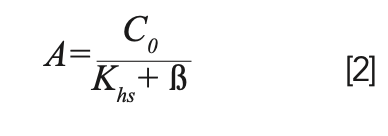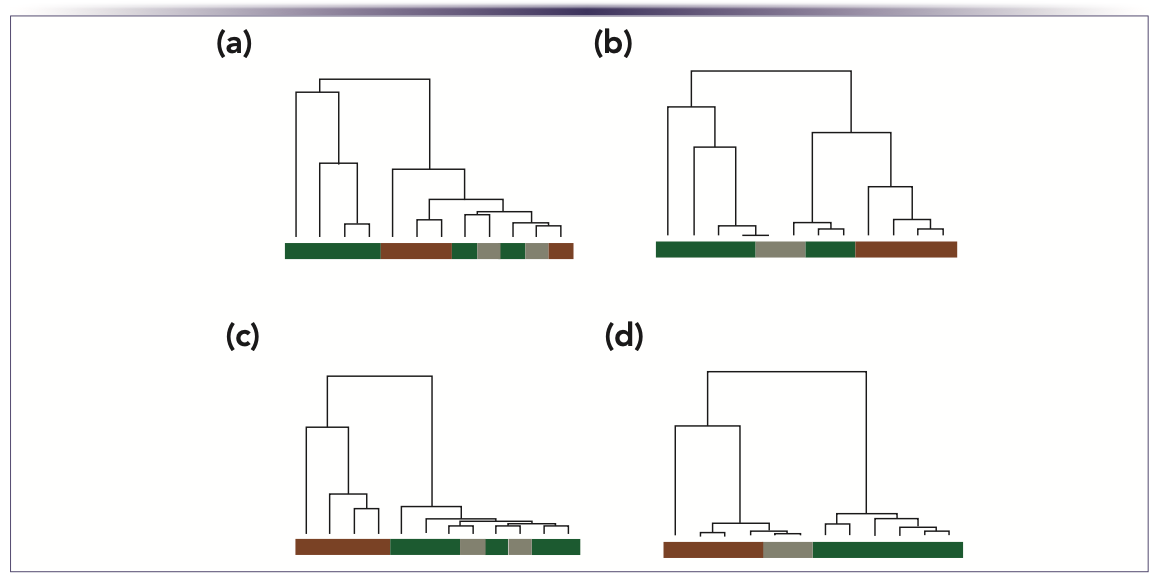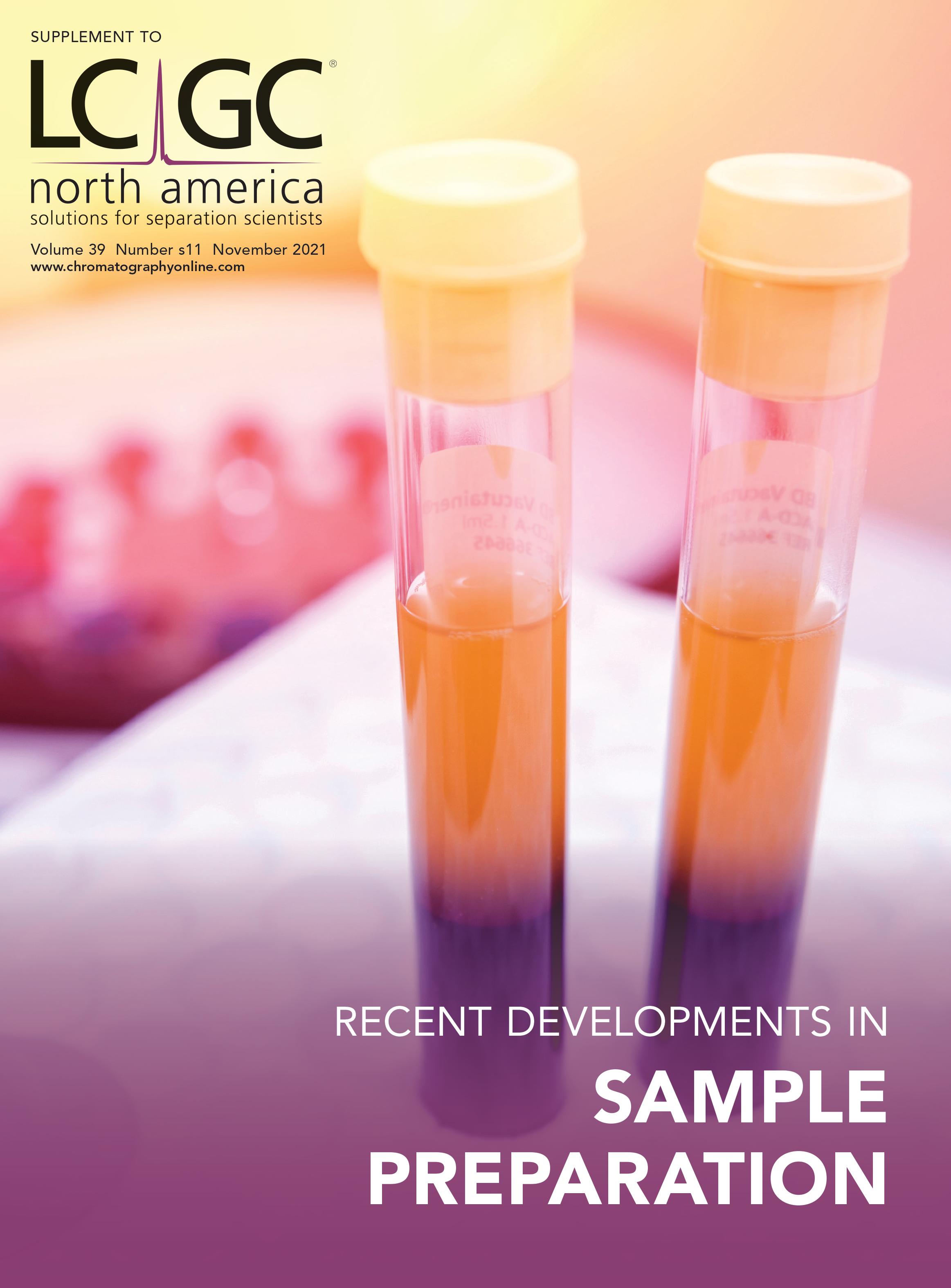Multiple-Cumulative Trapping: A Fascinating Option to Enhance Headspace Profile
Multiple-cumulative trapping headspace extraction coupled with high concentration capacity tools, such as solid-phase microextraction (SPME), has recently shown great potential in enhancing the overall sensitivity of the volatile profile and the capability to provide a highly informative profile to facilitate answering complex questions. This contribution presents the benefits of applying this technique in food analysis.
The idea of exploiting an enrichment step through multiple-cumulative trapping (MCT) was presented for the first time by Lipinski in 2000 (1) to enhance the sensitivity of pesticide analysis in water extracted by direct-immersion (DI) solid-phase microextraction (SPME). In 2012, Chin and associates (2) used the same idea to increase the odor detection limit in gas chromatography (GC)–olfactometry. The headspace (HS) of wine samples was extracted using different SPME polymeric coatings, and the compounds (after desorption in the GC injector) were cumulatively focused at the head of the column using a cold trap before releasing them for the GC analysis. The focus was mainly on the optimization of the latter trapping step, and the potential of the idea was not developed further. Recently, the idea was reconsidered and explored systematically using a fully automated autosampler and an enrichment platform (3,4).
The MCT technique can be easily automated and applied to perform multiple extractions from single vials (SV–MCT) or multiple vials (MV–MCT). These two modalities provide diverse and equally beneficial perspectives in terms of sensitivity. Moreover, the MCT extraction technique can be used to explore fundamental theoretical aspects of headspace quantification applicability.
Insights into this technique are discussed here, illustrated by an application to the analysis of olive oil. The theory behind the possibility of performing quantification in headspace is briefly reviewed, and the role that MCT extraction can play in this regard is discussed, thus verifying the common assumption that correlates the chromatographic area response with the sample concentration of the compounds. Furthermore, the enhancement of the overall sensitivity profile of a complex sample will be discussed in the perspective of targeted and untargeted analysis.
The Role of the Sample Volume in Headspace Extraction
According to the theory, the amount of each analyte extracted in the headspace is proportional to the initial concentration (C0) in the sample under both equilibrium and non-equilibrium conditions. Equation 1 pinpoints this correlation for a high-concentration-capacity tool, accounting for the contribution of the distribution coefficient HS/sample and fiber/HS (Khs and Kfh, respectively), as well as for the volume of the sample (Vs), the HS (Vh) and the polymeric coating (Vf) used:

This proportionality can also be expressed as:

where A is the chromatographic area, and ß is the phase ratio (ß=Vh/Vs), when not considering the additional effect of the fiber selectivity and the partition coefficient between the headspace and the fiber (Kfh) (5).
Such an equation applies when the headspace is not saturated, meaning that when subsequent extractions are performed from the same vial, an exponential decline of the area response is recorded. However, the non-saturation of the headspace is fundamental when the goal is accurate quantification through calibration (5). Therefore, it should not be neglected when the area intensity of different samples (without calibration) is used as an indicator of absolute concentration, as is done when large studies of cross-sample comparisons are performed (6). In fact, the saturation of the headspace can hinder differences among samples, weakening the potential of volatile fingerprinting.
As mentioned previously, headspace linearity is achieved when an exponential decline of the extracted compounds is recorded in subsequent extraction from the same vial, called multiple headspace extraction (MHE), according to equation 3:

where A is the chromatographic area, i indicates the number of extraction steps, and q is a constant.
To determine q, equation 3 is transformed into a linear equation by a logarithmic transformation (see equation 4):

As an analogy, the application of MCT can serve to easily assess the linearity conditions (4). It generates a cumulative curve described by a logarithmic equation, such as equation 5:

which is transformed into a linear curve to determine q by an exponential transformation according to equation 6:

The headspace linearity can easily be verified using both approaches, namely MHE or MCT, with the latter providing an easier evaluation, because instead of a decrease of the amount recorded, an increase is observed, improving the detectability and quantification of the compounds of interest. An increase of the area response proportional to the number of MCT extractions indicates saturation of the headspace, while a logarithmic increase reflect a non-saturation condition. Figure 1a represents a schematic of the area response in function of MCT extractions. It is noteworthy that the use of too high a sample volume, such as the volume generally reported in the literature for virgin olive oil volatile profiling (~1.5 g [7-8]) largely saturates the headspace, detrimentally impairing the overall profile. It has been recently shown that the headspace linearity is verified when a much lower amount of sample (0.1 g) is used compared to the amount generally reported in the literature (4). Moreover, the increase of the sample volume slightly increases the extraction yield of the compounds with the lower octanol-air partition value (Koa), whereas no significant gain of sensitivity is recorded for the lower Koa. A higher increase in the extraction yield of low Koa compounds is observed when longer extraction times are used (30 min vs. 10 min). Nevertheless, in both cases, the gain in sensitivity is not higher than 2.5-fold against a sample mass increase for more than 10 times (Figure 1b) (4).
FIGURE 1: (a) Schematic of the increment observed applying multiple-cumulative trapping (MCT) extraction when the headspace is saturated (orange line) or not saturated (blue line). (b) Change in extraction efficiency between 1.5 g and 0.1 g of virgin olive oil when extracting for 10 min (blue dots) or 30 min (orange dots) as a function of Koa. (c) Change in extraction efficiency as a function of log Koa when performing one extraction for 30 min or three extractions of 10 min each, both using 1.5 g (orange dots) or 0.1 g (blue dots) of virgin olive oil.

Therefore, the use of a sample volume that causes saturation of the headspace offers no significant benefit in sensitivity, and it may be detrimental in analyzing the overall profile of a food sample. Undeniably, when complex food samples are studied, the high complexity of the aroma profile, along with the broad dynamic concentrations of the volatile components, makes it almost impossible to meet the requirement of no saturation for all the compounds (4,6).
Exploit Multi-Cumulative Trapping Extraction to Improve Sensitivity
Multi-cumulative trapping (MCT) has been explored somewhat in the past, as reported in the introduction. However, only recently it has started to be investigated systematically. Two methods can be use. One involves extracting multiple times from the same vial (SV–MCT), and the other requires extraction from multiple vials containing the same sample (MV–MCT). The latter will clearly multiply the response of the extracted analytes for the number of folds the extraction is repeated, thus increasing sensitivity accordingly. Thus the MV–MCT modality can be particularly beneficial when the goal is to maximize sensitivity for trace compounds. On the other hand, SV–MCT may lead to one of two different outcomes: If the compounds are saturating the headspace, the result will be a multiplication of the response, just like for MV–MCT; if the headspace is not saturated, a logarithmic increase of the signal will be observed with the incremental extraction. A combined situation may occur where the increment is linear up to a certain number of repeated extraction of the headspace and then logarithmic.
The number of repetitive extractions thus becomes an important additional parameter to be optimized as a compromise between sensitivity and throughput. In this regard, it is interesting to “tune the sensitivity” by using shorter repeated extractions rather than a single longer one. In fact, a shorter extraction time reduces the competitive processes that may occur when porous fibers (such as DVB/CAR/PDMS) are used (9–11), while the MCT extractions compensate for the loss of sensitivity. Research on the targeted analysis of virgin olive oil volatiles has shown that shorter repeated extractions significantly improve the extraction of compounds with a higher Koa value compared to those with a lower one, when compared to the same overall extraction time (three 10-min extractions compared to a single 30-min extraction) (Figure 1c) (4).
Untargeted Cross-Sample Comparison
When performing untargeted studies, the common assumption is that the area intensity is a direct indicator of the absolute concentration in the sample. Nevertheless, as mentioned previously, to apply this assumption, the headspace linearity condition should be verified (5,6), which is rarely done. In fact, starting from biased data as in the case of saturation of the HS may hinder the ability to detect significant differences even when advanced chemometric tools are used (such as hierarchical cluster analysis or random forest).
An example has been reported for the capability of clustering olive oil according to the commercial quality: extra-virgin (EVO), virgin (VO), or lampante oil (LO) (3,4). Saturated headspace and non-saturated headspace, using different amounts of sample, were compared. As shown in Figure 1b, no significant increase of sensitivity was shown using 1.5 g rather than 0.1 g of sample; on the contrary, olive oil commercial quality clustering improved when the smaller sample volume was used (Figure 2a and 2b) (modified from 4).
FIGURE 2: Hierarchical cluster analysis of commercial categories of olive oil, namely EVO (green color bar), VO (gray color bar), and LO (brown color bar) obtained using different HS-SPME conditions. (a) 1.5 g of sample extracted for 10 min at 43 °C; (b) 0.1 g of sample extracted for 10 min at 43 °C; (c) 0.1 g of sample extracted for 30 min at 43 °C, and (d) 0.1 g of sample extracted three times for 10 min each at 43 °C using the MCT-HS-SPME approach (modified from [4]).

Contextually, the exploitation of SV-MCT-HS-SPME has shown to positively reflect sample classification in a powerful cross-sample comparison (4). A perfect discrimination among the three olive oil categories was obtained with three 10-min runs of MCT-HS-SPME, compared to both a single 10-min extraction and a single 30-min extraction (Figure 2c and 2d), suggesting a less significant role of the most volatile compounds (generally lower Koa) and an important role of the compounds with higher Koa in the discrimination capability.
Conclusions
MCT extraction is a powerful tool that opens new perspectives. Further investigation is certainly needed to fully reveal the many benefits that can provide. MCT-HS-SPME has shown capability to better investigate the headspace of foods and answer both targeted and untargeted questions. Its application with different headspace extraction tools and polymeric coatings to different food samples will be of high value to fully understand the applicability and potentiality of both MV-HS–MCT and SV-HS–MCT. Finally, of high interest is also the investigation of the application of MCT approach to direct immersion applications, especially linked to contaminants analysis in food samples.
References
(1) J. Lipinski, Fresenius. J. Anal. Chem. 367, 445–449 (2000).
(2) S.T. Chin, G.T. Eyres, and P.J. Marriott, J. Chromatogr. A 1255, 221–227 (2012).
(3) S. Mascrez and G. Purcaro, J. Sep. Sci. 43, 1934–1941 (2020).
(4) S. Mascrez and G. Purcaro, Anal. Chim. Acta 1122, 89–96 (2020).
(5) B. Kolb and L.E. Ettre, Static Headspace-Gas Chromatography: Theory and Practice (Wiley-VHC, New York, New York, 2006).
(6) F. Stilo, C. Cordero, B. Sgorbini, C. Bicchi, and E. Liberto, Separations 6, 34 (2019).
(7) G. Purcaro, C. Cordero, E. Liberto, C. Bicchi, and L.S. Conte, J. Chromatogr. A 1334, 101–111 (2014).
(8) F. Magagna, L. Valverde-Som, C. Ruíz-Samblás, L. Cuadros-Rodríguez, S.E. Reichenbach, C. Bicchi, and C. Cordero, Anal. Chim. Acta 936, 245–258 (2016).
(9) M.J. Trujillo-Rodríguez, V. Pino, E. Psillakis, J.L. Anderson, J.H. Ayala, E. Yiantzi, and A.M. Afonso, Anal. Chim. Acta 962, 41–51 (2017).
(10) T. Górecki, X. Yu, and J. Pawliszyn, Analyst 124, 643–649 (1999).
(11) E. Gionfriddo, É.A. Souza-Silva, and J. Pawliszyn, Anal. Chem. 87, 8448–8456 (2015).
Steven Mascrez is a PhD student, Damien Eggermont is a master’s degree student, and Giorgia Purcaro is a professor of analytical chemistry in the Gembloux AgroBio Tech Department, all at the University of Liège, in Gembloux, Belgium. Direct correspondence to: gpurcaro@uliege.be

Analytical Challenges in Measuring Migration from Food Contact Materials
November 2nd 2015Food contact materials contain low molecular weight additives and processing aids which can migrate into foods leading to trace levels of contamination. Food safety is ensured through regulations, comprising compositional controls and migration limits, which present a significant analytical challenge to the food industry to ensure compliance and demonstrate due diligence. Of the various analytical approaches, LC-MS/MS has proved to be an essential tool in monitoring migration of target compounds into foods, and more sophisticated approaches such as LC-high resolution MS (Orbitrap) are being increasingly used for untargeted analysis to monitor non-intentionally added substances. This podcast will provide an overview to this area, illustrated with various applications showing current approaches being employed.
Profiling Volatile Organic Compounds in Whisky with GC×GC–MS
November 1st 2024Researchers from Austria, Greece, and Italy conducted a study to analyze volatile organic compounds (VOCs) present in Irish and Scotch whiskys using solid-phase microextraction (SPME) Arrow with comprehensive two-dimensional gas chromatography coupled to mass spectrometry (GC×GC–MS) to examine the organoleptic characteristics that influence the taste of spirits.
Green Chemistry: What is it (and What Is It Not)? And How Does It Apply to Gas Chromatography?
October 31st 2024Everyone is talking about sustainability, and organizations are creating sustainability programs. But what does green chemistry really mean, and how does it apply to gas chromatography?